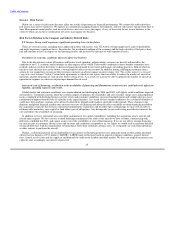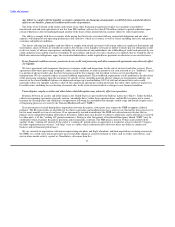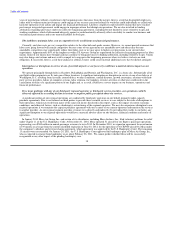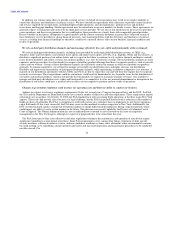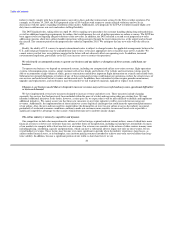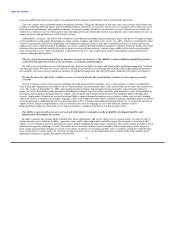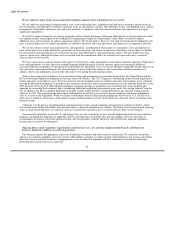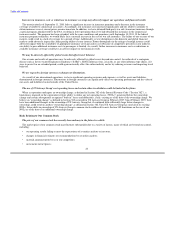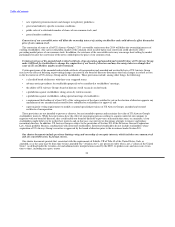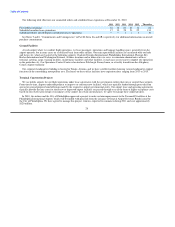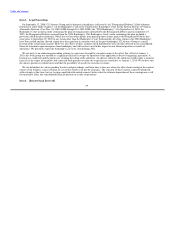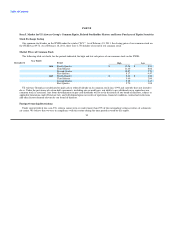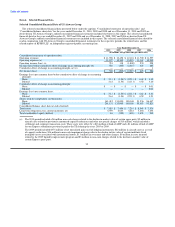US Airways 2010 Annual Report Download - page 23
Download and view the complete annual report
Please find page 23 of the 2010 US Airways annual report below. You can navigate through the pages in the report by either clicking on the pages listed below, or by using the keyword search tool below to find specific information within the annual report.
Table of Contents
We are subject to many forms of environmental regulation and may incur substantial costs as a result.
We are subject to increasingly stringent federal, state, local and foreign laws, regulations and ordinances relating to the protection of
the environment, including those relating to emissions to the air, discharges to surface and subsurface waters, safe drinking water, and the
management of hazardous substances, oils and waste materials. Compliance with all environmental laws and regulations can require
significant expenditures.
Several U.S. airport authorities are actively engaged in efforts to limit discharges of de-icing fluid (glycol) to local groundwater, often
by requiring airlines to participate in the building or reconfiguring of airport de-icing facilities. Such efforts are likely to impose
additional costs and restrictions on airlines using those airports. We do not believe, however, that such environmental developments will
have a material impact on our capital expenditures or otherwise adversely affect our operations, operating costs or competitive position.
We are also subject to other environmental laws and regulations, including those that require us to remediate soil or groundwater to
meet certain objectives. Under federal law, generators of waste materials, and owners or operators of facilities, can be subject to liability
for investigation and remediation costs at locations that have been identified as requiring response actions. We have liability for such
costs at various sites, although the future costs associated with the remediation efforts are currently not expected to have a material
adverse affect on our business.
We have various leases and agreements with respect to real property, tanks and pipelines with airports and other operators. Under these
leases and agreements, we have agreed to standard language indemnifying the lessor or operator against environmental liabilities
associated with the real property or operations described under the agreement, even if we are not the party responsible for the initial event
that caused the environmental damage. We also participate in leases with other airlines in fuel consortiums and fuel committees at
airports, where such indemnities are generally joint and several among the participating airlines.
There is increasing global regulatory focus on climate change and greenhouse gas emissions. In particular, the United States and the
EU have developed regulatory requirements that may affect our business. The U.S. Congress is considering climate-related legislation to
reduce emissions of greenhouse gases. Several states have also developed measures to regulate emissions of greenhouse gases, primarily
through the planned development of greenhouse gas emissions inventories and/or regional greenhouse gas cap and trade programs. In late
2009 and early 2010, the U.S. EPA adopted regulations requiring reporting of greenhouse gas emissions from certain facilities and
updating the renewable fuels standard, and is considering additional regulation of greenhouse gases under the existing federal Clean Air
Act. In addition, the EU has adopted legislation to include aviation within the EU's existing greenhouse gas emission trading scheme
effective in 2012. This legislation has been legally challenged in the EU but we have had to begin complying and incurred additional
costs as a result of this legislation. While we cannot yet determine what the final regulatory programs will be in the U.S., the EU or in
other areas in which we do business, such climate change-related regulatory activity in the future may adversely affect our business and
financial results.
California is in the process of implementing environmental provisions aimed at limiting emissions from motorized vehicles, which
may include some airline belt loaders and tugs and require a change of ground service vehicles. The future costs associated with replacing
some or all of our ground fleets in California cities are currently not expected to have a material adverse affect on our business.
Governmental authorities in several U.S. and foreign cities are also considering or have already implemented aircraft noise reduction
programs, including the imposition of nighttime curfews and limitations on daytime take-offs and landings. We have been able to
accommodate local noise restrictions imposed to date, but our operations could be adversely affected if locally-imposed regulations
become more restrictive or widespread.
Ongoing data security compliance requirements could increase our costs, and any significant data breach could harm our
business, financial condition or results of operations.
Our business requires the appropriate and secure utilization of customer and other sensitive information. We cannot be certain that
advances in criminal capabilities, discovery of new vulnerabilities, attempts to exploit existing vulnerabilities in our systems, data thefts,
physical system or network break-ins or inappropriate access, or other developments will not compromise or breach the technology
protecting the networks that access and store
22





